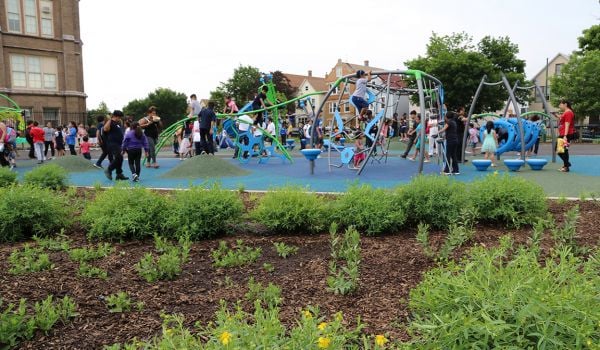“Infrastructure” is the talk of the town in Washington, DC as cracked bridges, melting cables, and maxed out electric grids make news every week.
But it is not just the roads and wires that carry our goods and information that are in need of an update. The signs of a broader decay in our public information ecosystem are everywhere: disappearing local news coverage, a lack of trust in our elections and political processes, lackluster government service delivery as illustrated with chaotic vaccine signup systems, rampant scams that make it difficult for the average American to tell legitimate government communications from phishing attacks. Our “civic infrastructure” is depleted, underfunded, and inadequate for a 21st-century democracy.
In a 2015 Aspen report, Jill Blair and Malka Kopell defined “civic infrastructure” as the “system of organizations and relationships — with the explicit goal of maximizing public participation and agency in service of better public problem-solving.” That includes everything from the physical spaces where people gather, to civic information sources and digital channels for learning about and engaging with government and civic initiatives.
The pandemic revealed vulnerabilities in brittle systems but also opened opportunities for innovations that should continue. School boards, city and county councils, and countless other boards and community organizations opened up their meetings — many for the first time — making for “a golden age of public access to the more responsible governmental bodies.”
However, even with these innovations, many people feel disempowered, as though their voices do not matter and the system is rigged against them. This is what political scientists call a deficit of “political efficacy” — that sense that the government “listens to people like me.”
This leads to a negative feedback loop: people do not trust their government and elected leaders, which causes them to disengage, which leads to policy that is less responsive, participatory, or inclusive.
The good news is that there is considerable bipartisan agreement and momentum for investing in civic assets. The Great American Outdoors Act, signed by then-President Trump in 2020, will provide new funding for public parks (and not a moment too soon given the recent D+ grade from the American Society for Civil Engineers.) The American Rescue Plan, which passed in March 2021, provided $1 billion in additional funding for the Technology Modernization Fund, that allows federal agencies to propose transformative technology projects to make their programs work more effectively and better engage citizens.
Meanwhile, the Office of Management and Budget signaled that a fundamental rethinking of agency processes is underway with its recent request for information on how the government can support underserved communities. The request specifically asked for input on ways to reduce burdens and barriers to accessing government services and how to better incorporate input from historically and currently underserved communities into the policymaking process.
The Biden-Harris administration has put together a proposal for a $10 billion “Community Revitalization Fund to support community-led civic infrastructure projects that create innovative shared amenities, spark new local economic activity, provide services, build community wealth, and strengthen social cohesion.” This little talked about proposal coud be the key to unlock a truly multi-racial, multi-ethnic democracy for the 21st century. If these dollars went to the places which bring people together in communities, from libraries to parks and recreation centers to mutual aid networks and business incubators, there is an opportunity to build much needed civic infrastructure within communities.
A fundamental investment in civic infrastructure can open up previously closed public services and participatory processes. New Jersey’s first Chief Innovation Officer, Beth Simone Noveck, recently wrote, “The smartest cities are those that listen to their citizens.” As the discussion over the infrastructure package continues, it is essential that the projects and investments under consideration include mechanisms for trusted information to be provided and for proactive engagement with communities, especially those who have not been at the table in the past. If done well, this is a once in a lifetime opportunity to re-invest in our physical and civic infrastructure, to strengthen communities, and lay the groundwork for what comes next.
There is an opportunity to address the historical lack of intergenerational wealth building in Black and brown communities. Through addressing the interconnected systemic challenges in communities of color from lack of affordable housing to chronic disinvestment in public spaces and transportation infrastructure. Addressing racial discrimination in these communities could spark a new generation of civic leaders; creating new, truly equitable mechanisms for people to engage and have agency in their lives. It is an opportunity to re-invest in a way that lifts and amplifies all communities.
By prioritizing equity and genuine participation, and by working in deep partnership with community foundations and investing in catalytic leaders, civic infrastructure can help us envision a stronger country.
Dr. Hollie Russon Gilman is a Senior Fellow at New America's Political Reform Program and an Affiliate Fellow at Harvard's Ash Center. She is the author of “Democracy Reinvented: Participatory Budgeting and Civic Innovation in America” and most recently co-author of “Civic Power: Rebuilding American Democracy in an Era of Crisis.“ She served as Open Government and Innovation Advisor in the White House Office of Science and Technology Policy.
Marci Harris, JD, LL.M., is the co-founder and CEO of POPVOX and co-founder of the newly launched POPVOX Foundation.
















